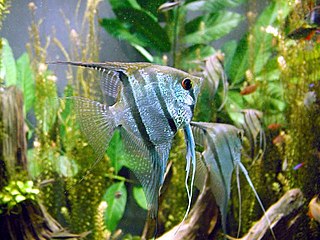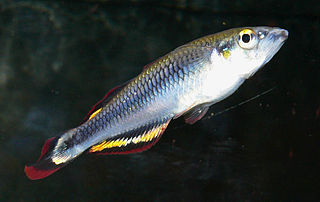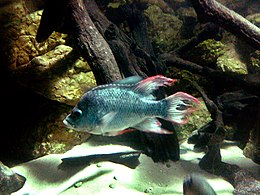
Cichlids are fish from the family Cichlidae in the order Cichliformes. Cichlids were traditionally classed in a suborder, the [Labroidei]], along with the wrasses (Labridae), in the order Perciformes, but molecular studies have contradicted this grouping. The closest living relatives of cichlids are probably the convict blennies, and both families are classified in the 5th edition of Fishes of the World as the two families in the Cichliformes, part of the subseries Ovalentaria. This family is both large and diverse. At least 1,650 species have been scientifically described, making it one of the largest vertebrate families. New species are discovered annually, and many species remain undescribed. The actual number of species is therefore unknown, with estimates varying between 2,000 and 3,000.

Etroplus is a small genus of cichlids native to southern India and Sri Lanka. Together with Pseudetroplus, they are the only ciclids of this region.

Paratilapia is a genus of cichlids generally restricted to Madagascar. These are large, dark cichlids densely covered in light spots. An additional very poorly known species from the Congo River basin in mainland Africa is sometimes also placed in the genus, but this is highly questionable and arguably it is better placed in the "wastebasket genus" Haplochromis for the time being.

Herichthys is a small genus of cichlid fishes. Most are endemic to Mexico, but H. cyanoguttatus is also found in southern Texas, and has been introduced to central Texas and Florida. In 2015, the genus was split, and 7 species moved into Nosferatu.

The Bedotiinae are a subfamily of the family Melanotaeniidae, known as the Madagascar rainbowfish, Madagascan rainbowfish, or Malagasy rainbowfish due to their endemism to Madagascar. It includes two genera, Bedotia and Rheocles.

Paretroplus is a genus of fishes in the cichlid family, all of which are endemic to lakes and rivers of Madagascar. The vast majority are threatened and restricted to the northwestern part of the island. Only P. polyactis is found in the southern half of Madagascar and only P. polyactis and P. gymnopreopercularis are found in eastern drainages. Most are restricted to freshwater, but at least P. polyactis and P. maromandia can also be seen in brackish habitats.

The damba is a species of cichlid.

The kotsovato is a species of cichlid from northwestern Madagascar. As presently defined its range spans several river basins, but this could possibly include more than one species. It is threatened by habitat loss and competition from introduced species. This relatively elongate Paretroplus reaches about 16 centimetres (6.3 in) in length and is closely related to P. gymnopreopercularis, which it resembles. The specific name honours the French fisheries scientist André Kiener.
The kotso is a species of cichlid fish from northwestern Madagascar. Currently rated as data deficient by the IUCN, this species is virtually unknown. The only known specimen is a juvenile that was collected more than 80 years ago. It is not entirely clear where it was collected, but likely from the Maintimaso River or Lake Ambanja, which both are part of the Betsiboka River drainage. Erroneously, the name P. petiti has often been applied to members of a different species, P. dambabe. The specific name honours the French zoologist and anatomist Georges Petit (1892-1973) of the Muséum national d’Histoire naturelle, who collected type.

Paretroplus polyactis is a vulnerable species of cichlid found widely in fresh and brackish water in coastal regions and associated river basins in eastern Madagascar. It is the only Paretroplus found in the southern half of Madagascar, and one of only two found in eastern drainages. P. polyactis is threatened by habitat loss and overfishing. This relatively deep-bodied Paretroplus reaches 30 centimetres (12 in) in length. It shares a large part of its range with a cichlid from another genus, Ptychochromis grandidieri.

Ptychochromis grandidieri is a species of fish in the family Cichlidae endemic to river basins along a large part of the eastern coast of Madagascar, although it has been recorded as far as 100 km (62 mi) inland. Uniquely in the genus Ptychochromis, this species also occurs in brackish water. It reaches 21.3 cm (8.4 in) in standard length. It shares a large part of its range with a cichlid from another genus, Paretroplus polyactis. The specific name honours Alfred Grandidier (1836-1921), the French naturalist and explorer who, with Henri Joseph Léon Humblot (1852-1914), collected the type.
Ptychochromis loisellei is a species of cichlid from the Mahanara River basin north of Sambava in northeastern Madagascar. It remains common within its small range, but it is threatened by habitat loss and introduced species. It reaches about 11.9 centimetres (4.7 in). The similar named Paretroplus loisellei is also restricted to the Mahanara River basin. The specific name honours Paul V. Loiselle, Emeritus Curator of Freshwater Fishes at the New York Aquarium and a researcher in, and campaigner for the conservation of, the freshwater fish of Madagascar.

The green chromide is a species of cichlid fish that is native to fresh and brackish water habitats in some parts in India such as Kerala, Goa, Chilika Lake in Odisha and Sri Lanka. The species was first described by Marcus Elieser Bloch in 1790. Other common names include pearlspot cichlid, banded pearlspot, and striped chromide. In Kerala, it is known locally as the karimeen (കരിമീൻ). In Goa the fish is known as kalundar. In Odisha, the local name is kundal(କୁଣ୍ଡଳ ମାଛ). In Sri Lanka this fish is known as koraliya (කොරළියා).

The Pseudocrenilabrinae are a subfamily in the cichlid family of fishes to which, according to a study from 2004, includes all the Middle Eastern and African cichlids with the exception of the unusual Heterochromis multidens and the Malagasy species. This subfamily includes more than 1,100 species. Previous authors recognized additional African subfamilies, e.g. the Tilapiinae of Hoedeman (1947), Tylochrominae of Poll (1986), or Boulengerochrominae of Tawil (2001).

The Astronotinae are a subfamily of cichlids from South America, where they are found in the Amazon, Orinoco, Paraná, and Paraguay River basins, and various rivers in the Guianas. The subfamily includes three genera, each with two species. Although in other classifications all three genera are placed in the subfamily Cichlinae with Astronotus being the only genus in the monogeneric tribe Astronotini of the subfamily Cichlinae and the other two genera being placed in the tribe Cichlini.

Heroini is a fish tribe from the Cichlasomatinae subfamily in the cichlid family. All cichlids native to the Greater Antilles, United States, Mexico and northern Central America are members of this tribe. It also includes most cichlid species in southern Central America and several species from South America. A large percentage of its species were formerly placed in the genus Cichlasoma, but have since been moved to other genera.
Ptychochromis ernestmagnusi is a species of fish cichlid only known from the Mananara du Nord River in northeastern Madagascar, but it is probably more widespread in that region. If so, it likely occurs in the Mananara-Nord Biosphere Reserve, which would give it a level of protection. It can reach 14.7 cm (5.8 in) in standard length. The specific name honours Ernest Magnus (1908-1983) who was the uncle of the German-American marine biologist and ichthyologist Rudolf Arndt who gave generous support to the author's research, at the request of Anrdt's family, whose “generous gift” supported the authors’ research. Magnus played an important part in assisting the Arndt family to survive in Berlin after the Second World War and then emigrate to New York City in 1950, by giving them "food, clothing, shelter, love, many kindnesses and moral support".
Paretroplus loisellei is a vulnerable species of cichlid fish from the Mahanara River basin north of Sambava in northeastern Madagascar. Until its scientific description in 2011, this population was usually referred to as Paretroplus sp. nov. "Ventitry" or included in P. damii, which it resembles. It reaches about 15 centimetres (5.9 in) in length, and is threatened by habitat loss and introduced species. The similar named Ptychochromis loisellei is also restricted to the Mahanara River basin. The specific name honours Paul V. Loiselle, Emeritus Curator of Freshwater Fishes at the New York Aquarium and a researcher in, and campaigner for the conservation of, the freshwater fish of Madagascar.

Cichlastomatini is a tribe of cichlids from South America, one of two tribes that make up the subfamily Cichlasomatinae. They were recognised in 1983 as an assemblage by the Swedish ichthyologist Sven O. Kullander by their four rather than five 5 dentary foramina in the lateralis canal system of the head, describing them as closely related to the genus Cichlasoma. Melanie Stiassny suggested that these fishes recognised as a clade by Kullander were divided into two groupings in 1991 which she termed cichlasomines and heroines, Kullander formally raised these to the tribes Cichlasomatini and Heroini of the subfamily Cichlasomatinae in 1999. In other classifications the tribe Cichlasomatini is placed in the subfamily Cichlinae.
Ptychochromis mainty is a species of cichlid from the subfamily Ptychochrominae, a subfamily which is endemic to the freshwaters of Madagascar. It has only been recorded from forested streams in the vicinity of Fort Dauphin in the south eastern part of the island. Its closest relative is Ptychochromis grandidieri.














